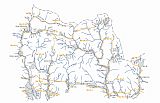Kvalitní cestovní pojištění
do zahraničí i do ČR.
Cestovní pojištění jednoduše, rychle a online na Top-Pojištění.cz s okamžitou platností a se slevou až 50 %.
Nejlevnější cestovní pojištění
na celý rok už od jediné koruny na den.
Krkonoše (KK)
Krkonoše: Unit photos | Add photo | Add information
Move on: Černá hora | Černá skála | Čertova hora | Čihadlo | Dívčí kameny | Dlouhý hřeben | Dvorský les | Harrachovy kameny | Janova skála | Javor | Jelení hora | Jelení vrch | Kotel | Kraví hora | Lesní hora | Liščí hora | Luboch | Luční hora | Lysá hora | Lysečinská hora | Malý Šišák | Medvědín | Mechovinec | Mravenčí vrch | Mrtvý vrch | Mužské kameny | Pěnkavčí vrch | Pevnost | Plešivec | Preislerův kopec | Přední Planina | Přední Žalý | Růžová hora | Slatinná stráň | Sněžka | Stoh | Struhadlo | Stříbrný hřbet | Studniční hora | Světlá | Svorová hora | Šeřín | Špičák | Tabule | Violík | Vlašský vrch | Vlčí hřeben | Vlčí hřeben - J vrchol | Vlčí hřeben - S vrchol | Vysoké kolo | Zadní Planina | Zadní Žalý | Zlaté návrší | Železný vrch
Related links: Krušné hory | Ještědsko-kozákovský hřbet | Jizerské hory | Krkonoše | Orlické hory | Králický Sněžník | Hanušovická vrchovina | Rychlebské hory | Hrubý Jeseník | Moravskoslezské Beskydy | Hostýnsko-vsetínská hornatina | Javorníky | Novohradské hory | Šumavské podhůří | Šumava | Český les
The Krkonoše Mountains are, for the Czech Republic, an exceptional range. They are the highest mountains in the Czech Republic – the peak Sněžka, which is situated on the border with Poland, measures 1,602 meters above sea level. In the west, the Krkonoše Mountains merge with the Jizerské Mountains and in the east, with the Broumovská Highlands. In the south, the Krkonoše Mountains are flanked by the Krkonoše Foothills and the northern part of the Krkonoše Mountains forms the border with Poland (the border runs along the main ridge). The geological base is very old, it consist mostly of Paleozoic and Prepaleozoic crystalline shale, with areas of granite and mica schist. The surface was shaped mainly by glaciers, which, for example, in the Labský Důl and Obří Důl valleys covered several kilometers. Several tens of avalanche tracks can be found in the former glacial cirques. It is possible to divide the mountains into two main ridges (the Silesian and the Czech) and into a number of saddles which run to the south (e.g. Vlčí and Žalský Hřbet, Černohorská and Růžohorská Rozsocha, Rýchory). The climate of the ridge part is very harsh, the average yearly temperature does not exceed 2 °C, the maximum snowfall is about two meters and the snow persists for more than half the year. Consequently, each year these mountains claim some victims, the overwhelming majority of which are undisciplined or unprepared tourists. It is more than necessary to abide by the “Ten Commandments” of the Mountain Rescue Services. Since the year 1963, most of the range has fallen under the protection of Krkonoše National Park (KRNAP), which includes a wide spectrum of biotopes, from broadleaved forest to alpine tundra. The alpine tundra, by itself, consisting of grasses, dwarf pine, rock fields and peat bogs, is one of the most precious habitats. The area above the treeline, which in the Krkonoše Mountains is usually at an average elevation of 1,230 meters above sea level, covers 50 km2, only 0.06 % of the total area of the Czech Republic. For Thousanders, the Krkonoše Mountains offer 54 principal thousand-meter high peaks which are evenly distributed throughout the whole range. Some of the peaks are, for preservation purposes, inaccessible, but there remain many which are worth the while to conquer and provide, in any season, an unforgettable experience.



